2013 HYUNDAI VELOSTER engine oil
[x] Cancel search: engine oilPage 293 of 372
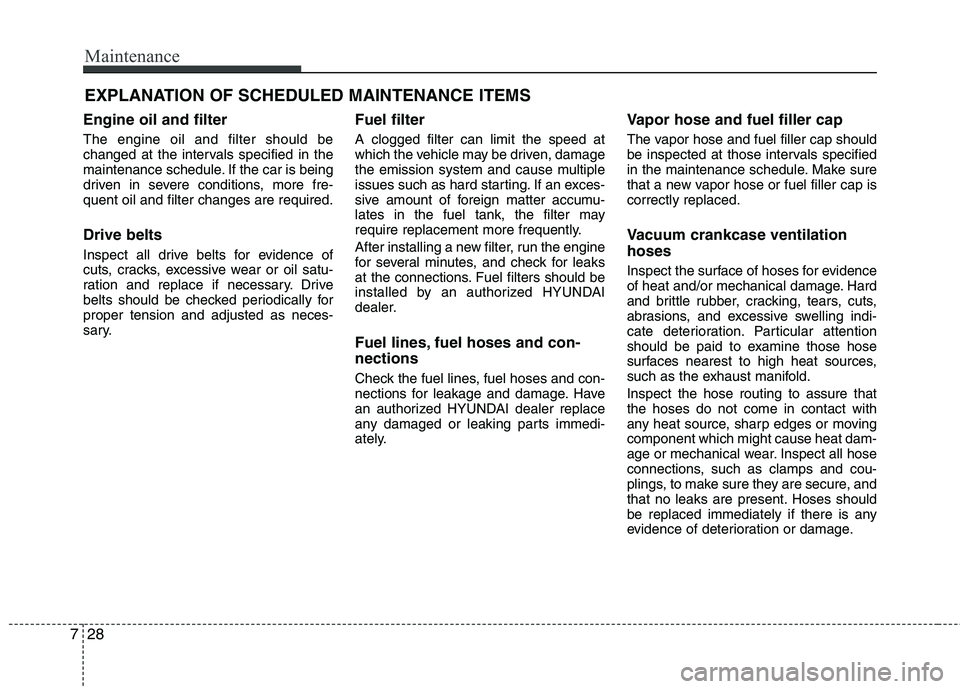
Maintenance
28 7
EXPLANATION OF SCHEDULED MAINTENANCE ITEMS
Engine oil and filter
The engine oil and filter should be
changed at the intervals specified in the
maintenance schedule. If the car is being
driven in severe conditions, more fre-
quent oil and filter changes are required.
Drive belts
Inspect all drive belts for evidence of
cuts, cracks, excessive wear or oil satu-
ration and replace if necessary. Drive
belts should be checked periodically for
proper tension and adjusted as neces-
sary.
Fuel filter
A clogged filter can limit the speed at
which the vehicle may be driven, damage
the emission system and cause multiple
issues such as hard starting. If an exces-
sive amount of foreign matter accumu-
lates in the fuel tank, the filter may
require replacement more frequently.
After installing a new filter, run the engine
for several minutes, and check for leaks
at the connections. Fuel filters should be
installed by an authorized HYUNDAI
dealer.
Fuel lines, fuel hoses and con-
nections
Check the fuel lines, fuel hoses and con-
nections for leakage and damage. Have
an authorized HYUNDAI dealer replace
any damaged or leaking parts immedi-
ately.
Vapor hose and fuel filler cap
The vapor hose and fuel filler cap should
be inspected at those intervals specified
in the maintenance schedule. Make sure
that a new vapor hose or fuel filler cap is
correctly replaced.
Vacuum crankcase ventilation
hoses
Inspect the surface of hoses for evidence
of heat and/or mechanical damage. Hard
and brittle rubber, cracking, tears, cuts,
abrasions, and excessive swelling indi-
cate deterioration. Particular attention
should be paid to examine those hose
surfaces nearest to high heat sources,
such as the exhaust manifold.
Inspect the hose routing to assure that
the hoses do not come in contact with
any heat source, sharp edges or moving
component which might cause heat dam-
age or mechanical wear. Inspect all hose
connections, such as clamps and cou-
plings, to make sure they are secure, and
that no leaks are present. Hoses should
be replaced immediately if there is any
evidence of deterioration or damage.
Page 296 of 372
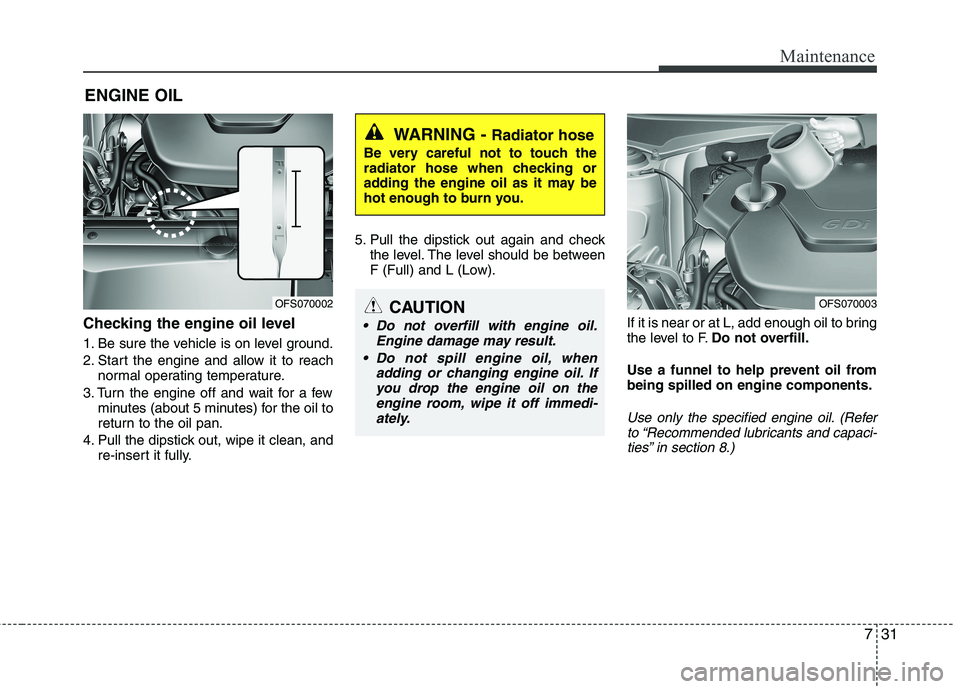
731
Maintenance
ENGINE OIL
Checking the engine oil level
1. Be sure the vehicle is on level ground.
2. Start the engine and allow it to reach
normal operating temperature.
3. Turn the engine off and wait for a few
minutes (about 5 minutes) for the oil to
return to the oil pan.
4. Pull the dipstick out, wipe it clean, and
re-insert it fully.5. Pull the dipstick out again and check
the level. The level should be between
F (Full) and L (Low).
If it is near or at L, add enough oil to bring
the level to F.Do not overfill.
Use a funnel to help prevent oil from
being spilled on engine components.
Use only the specified engine oil. (Refer
to “Recommended lubricants and capaci-
ties” in section 8.)
WARNING - Radiator hose
Be very careful not to touch the
radiator hose when checking or
adding the engine oil as it may be
hot enough to burn you.
CAUTION
Do not overfill with engine oil.
Engine damage may result.
Do not spill engine oil, when
adding or changing engine oil. If
you drop the engine oil on the
engine room, wipe it off immedi-
ately.
OFS070002OFS070003
Page 297 of 372
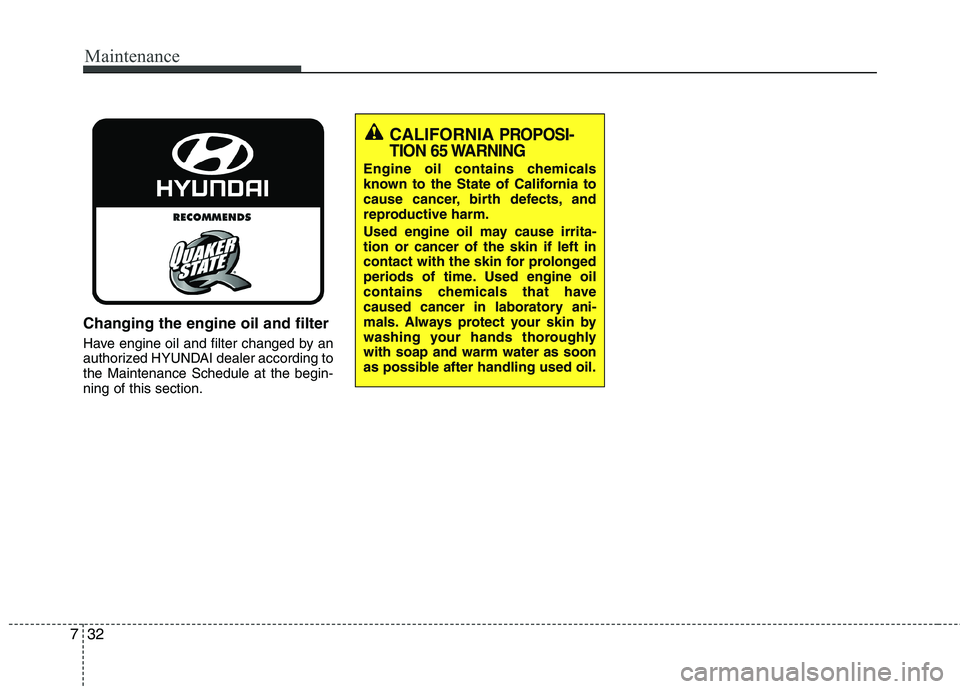
Maintenance
32 7
Changing the engine oil and filter
Have engine oil and filter changed by an
authorized HYUNDAI dealer according to
the Maintenance Schedule at the begin-
ning of this section.
CALIFORNIA PROPOSI-
TION 65 WARNING
Engine oil contains chemicals
known to the State of California to
cause cancer, birth defects, and
reproductive harm.
Used engine oil may cause irrita-
tion or cancer of the skin if left in
contact with the skin for prolonged
periods of time. Used engine oil
contains chemicals that have
caused cancer in laboratory ani-
mals. Always protect your skin by
washing your hands thoroughly
with soap and warm water as soon
as possible after handling used oil.
Page 301 of 372
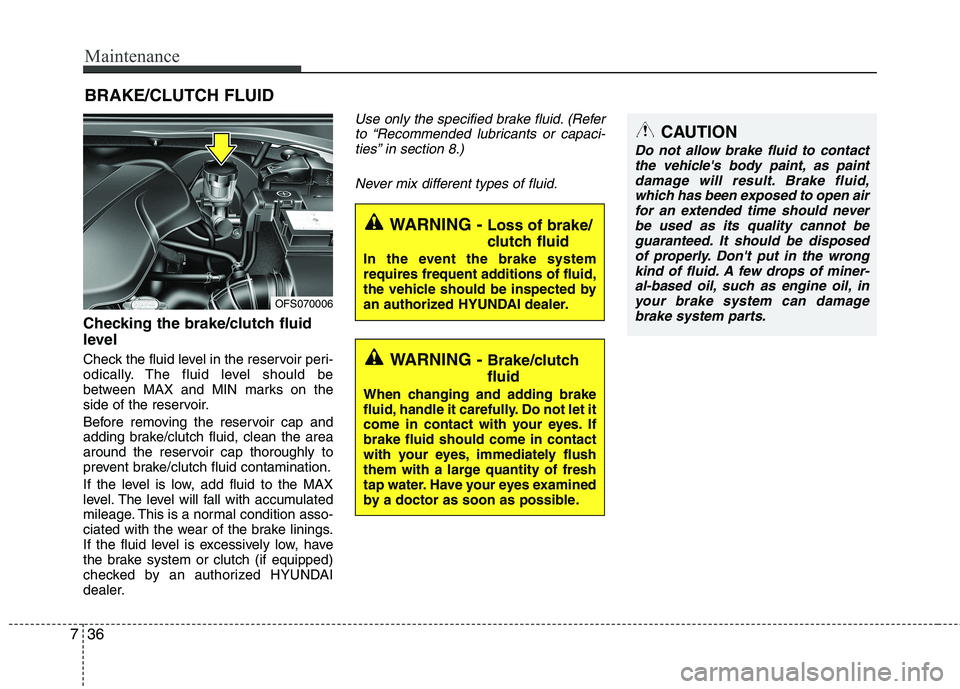
Maintenance
36 7
BRAKE/CLUTCH FLUID
Checking the brake/clutch fluid
level
Check the fluid level in the reservoir peri-
odically. The fluid level should be
between MAX and MIN marks on the
side of the reservoir.
Before removing the reservoir cap and
adding brake/clutch fluid, clean the area
around the reservoir cap thoroughly to
prevent brake/clutch fluid contamination.
If the level is low, add fluid to the MAX
level. The level will fall with accumulated
mileage. This is a normal condition asso-
ciated with the wear of the brake linings.
If the fluid level is excessively low, have
the brake system or clutch (if equipped)
checked by an authorized HYUNDAI
dealer.
Use only the specified brake fluid. (Refer
to “Recommended lubricants or capaci-
ties” in section 8.)
Never mix different types of fluid.
WARNING - Brake/clutch
fluid
When changing and adding brake
fluid, handle it carefully. Do not let it
come in contact with your eyes. If
brake fluid should come in contact
with your eyes, immediately flush
them with a large quantity of fresh
tap water. Have your eyes examined
by a doctor as soon as possible.
WARNING - Loss of brake/
clutch fluid
In the event the brake system
requires frequent additions of fluid,
the vehicle should be inspected by
an authorized HYUNDAI dealer.
CAUTION
Do not allow brake fluid to contact
the vehicle's body paint, as paint
damage will result. Brake fluid,
which has been exposed to open air
for an extended time should never
be used as its quality cannot be
guaranteed. It should be disposed
of properly. Don't put in the wrong
kind of fluid. A few drops of miner-
al-based oil, such as engine oil, in
your brake system can damage
brake system parts.
OFS070006
Page 312 of 372
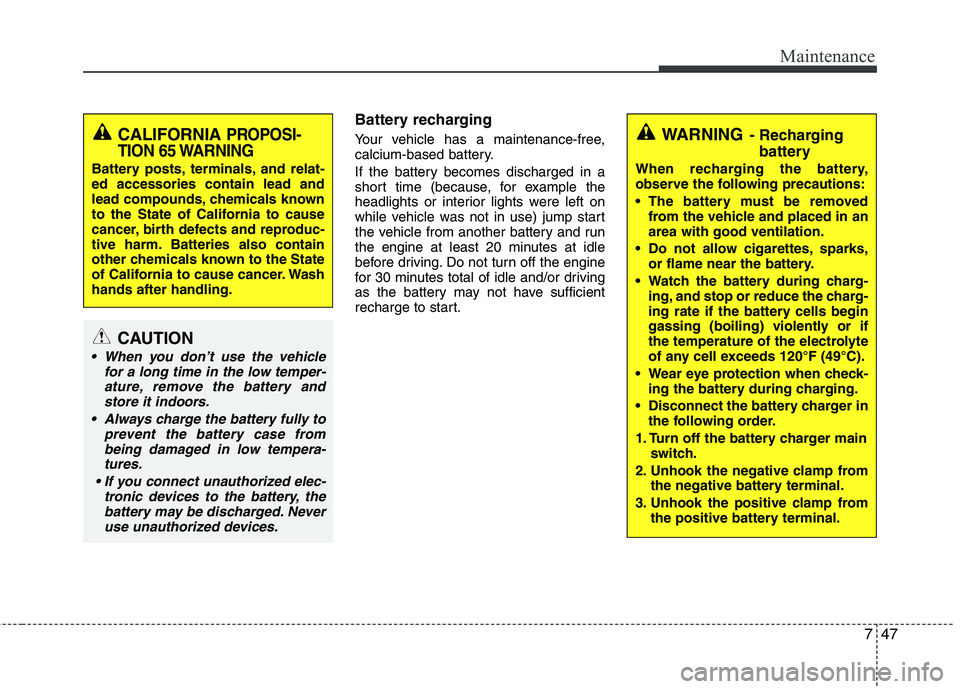
747
Maintenance
Battery recharging
Your vehicle has a maintenance-free,
calcium-based battery.
If the battery becomes discharged in a
short time (because, for example the
headlights or interior lights were left on
while vehicle was not in use) jump start
the vehicle from another battery and run
the engine at least 20 minutes at idle
before driving. Do not turn off the engine
for 30 minutes total of idle and/or driving
as the battery may not have sufficient
recharge to start.CALIFORNIA PROPOSI-
TION 65 WARNING
Battery posts, terminals, and relat-
ed accessories contain lead and
lead compounds, chemicals known
to the State of California to cause
cancer, birth defects and reproduc-
tive harm. Batteries also contain
other chemicals known to the State
of California to cause cancer. Wash
hands after handling.
CAUTION
When you don’t use the vehicle
for a long time in the low temper-
ature, remove the battery and
store it indoors.
Always charge the battery fully to
prevent the battery case from
being damaged in low tempera-
tures.
If you connect unauthorized elec-
tronic devices to the battery, the
battery may be discharged. Never
use unauthorized devices.
WARNING- Recharging
battery
When recharging the battery,
observe the following precautions:
The battery must be removed
from the vehicle and placed in an
area with good ventilation.
Do not allow cigarettes, sparks,
or flame near the battery.
Watch the battery during charg-
ing, and stop or reduce the charg-
ing rate if the battery cells begin
gassing (boiling) violently or if
the temperature of the electrolyte
of any cell exceeds 120°F (49°C).
Wear eye protection when check-
ing the battery during charging.
Disconnect the battery charger in
the following order.
1. Turn off the battery charger main
switch.
2. Unhook the negative clamp from
the negative battery terminal.
3. Unhook the positive clamp from
the positive battery terminal.
Page 327 of 372

Maintenance
62 7
FUSES
A vehicle’s electrical system is protected
from electrical overload damage by
fuses.
This vehicle has 2 fuse panels, one locat-
ed in the driver’s side panel bolster, the
other in the engine compartment.
If any of your vehicle’s lights, acces-
sories, or controls do not work, check the
appropriate circuit fuse. If a fuse has
blown, the element inside the fuse will be
melted.
If the electrical system does not work,
first check the driver’s side fuse panel.
Always replace a blown fuse with one of
the same rating.
Before replacing a blown fuse, discon-
nect the negative battery cable.
If the replacement fuse blows, this indi-
cates an electrical problem. Avoid using
the system involved and immediately
consult an authorized HYUNDAI dealer.
Three kinds of fuses are used: blade type
for lower amperage rating, cartridge type,
and multi fuse for higher amperage rat-
ings.
✽ ✽
NOTICE
The actual fuse/relay panel label may
differ from equipped items.
WARNING - Fuse replace-
ment
Never replace a fuse with any-
thing but another fuse of the
same rating.
A higher capacity fuse could
cause damage and possibly a
fire.
Never install a wire or aluminum
foil instead of the proper fuse -
even as a temporary repair. It may
cause extensive wiring damage
and a possible fire.
CAUTION
Do not use a screwdriver or any
other metal object to remove fuses
because it may cause a short circuit
and damage the system.
OBK079042 NormalNormal Blade type
Cartridge type
Multi fuseBlown
Blown
Normal Blown
Page 333 of 372

Maintenance
68 7
Description Fuse rating Protected component
STOP LP 15A Stop Lamp Switch, Key Solenoid, Stop Signal Relay, Smart Key Control Module
ECU 1 10A Immobilizer Module, Smart Key Control Module, ECM, Stop Lamp Switch
AMP 25A AMP
INVERTER 2 25A A/C Inverter Module
INTERIOR LAMP 10A Luggage Room Lamp, Map Lamp, Room Lamp, Vanity Lamp LH/RH, Overhead Console Lamp
SMART KEY 2 10A Smart Key Control Module, Immobilizer Module, Start Stop Button Switch
VACUUM PUMP (T-GDI) 15AEngine Room Fuse & relay box (Vacuum Pump Relay)
TCU (GDI) 15A TCM
TAIL LP LH 10ARear Combination Lamp LH, License Lamp LH/RH, Shift Lever Indicator, Instrument Cluster,
Multifunction Switch, Passenger Power Window Switch, Power Window Main Switch, AUX & USB Jack,
Inside Miiror A/C Control Module, ESC Off Switch, A/V & Navigation Head Unit, Crash Pad Switch,
Driver/Passenger Seat Warmer Switch, Head Lamp LH
S/HEATER 20A Driver/Passenger Seat Warmer
P/WDW LH 25A Power Window Main Switch
START 10ABurglar Alarm Relay, Transaxle Range Switch, Smart Key Control Module, ECM, TCM,
Engine Room Fuse & Relay Box (Start Relay)
B/UP LP 1 15A Back-Up Lamp Switch, Transaxle Range Switch
TAIL LP RH 10A Head Lamp RH, Rear Combination Lamp RH
SAFETY POWER
WINDOW25A Driver Safety Power Window Module
P/WDW RH 25A Power Window Main Switch, Passenger Power Window Switch, Rear Power Window Switch RH
B/UP LP 2 10AA/V & Navigation Head Unit, Transaxle Range Switch, MTS Module, TCM,
Back-Up Lamp Switch, Rear Combination Lamp LH/RH, IPS Control Module
ECU 2 15A Condenser, Ignition Coil #1/#2/#3/#4
HTD MIRR 10A ECM, A/C Control Module, Dirver/Passenger Power Outside Mirror
P/SEAT DRV 25A Not Used
Page 336 of 372

771
Maintenance
Description Fuse rating Protected component
FUSESENSOR 1 20A ECM
SENSOR 2GDI 10AOil Control Valve #1 (Intake)/#2 (Exhaust), Purge Control Solenoid Valve,
Variable Intake Solenoid Valve, Canister Close Valve,
Engine Room Fuse & Relay Box (A/CON Relay)
T-GDI 10AOil Control Valve #1 (Intake)/#2 (Exhaust), Purge Control Solenoid Valve,
Variable Intake Solenoid Valve, Canister Close Valve,
Engine Room Fuse & Relay Box (A/CON Relay), Waste gate valve, Recirulation valve
SENSOR 3 15A ECM, Oxygen Sensor (Up)/(Down), Engine Room Fuse & Relay Box (HAC Relay)
ECU 2 15A ECM
EcoShift dual clutch
transmission 3 (GDI)15A TCM
F/PUMP 15A Engine Room Fuse & Relay Box (Fuel Pump Relay)
ABS 1 40A ESC Module
ECU 1 30A Engine Room Fuse & Relay Box (Engine Conrol Relay, Fuse - ECU 2, ECU 3)
EcoShift dual clutch
transmission 2 (GDI)40A TCM
B+ 3 50ASmart Junction Box (Tail Lamp Relay, IPS Control Module (ARISU RT),
Fuse - STOP LP, SMART KEY 1/2, INVERTER 2, DR LOCK )
ECU 3 10A Sport Mode Switch
VACUUM PUMP
(T-GDI)20A Engine Room Fuse & Relay Box (Vacuum Pump Relay)